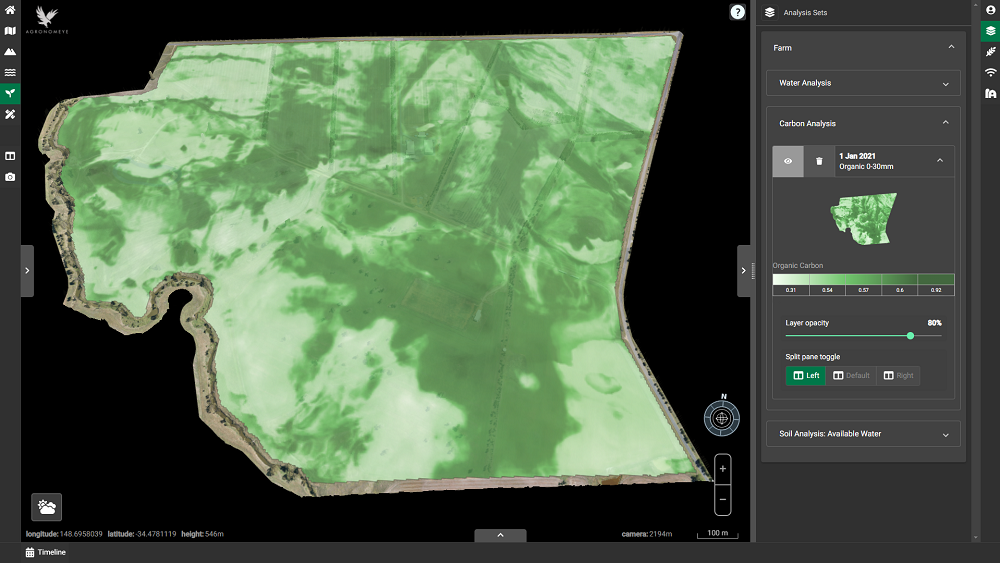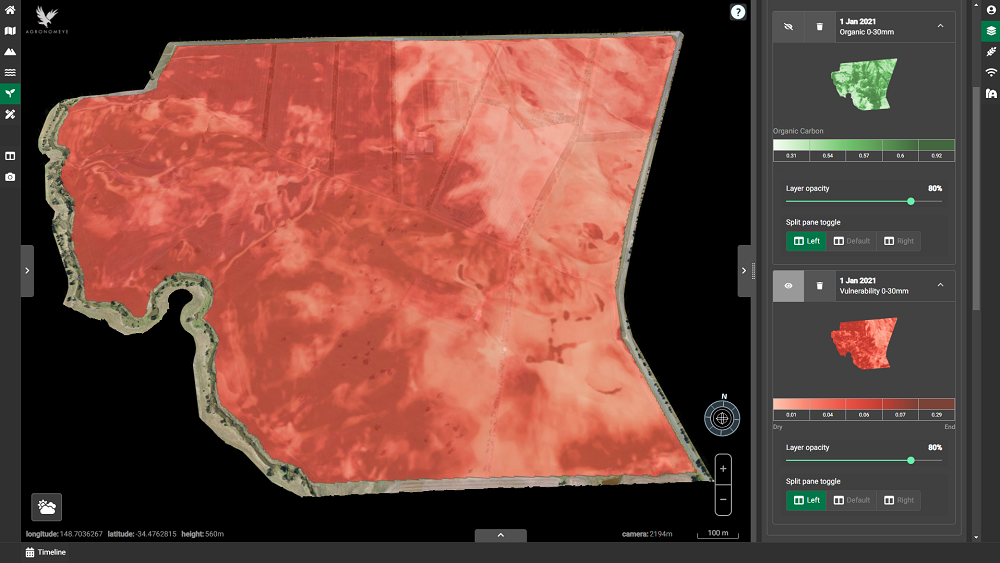
Research at BARS is enabling Australian growers to optimise their farm’s productivity and sustainability through developments in tactical and strategic management.
Understanding the stocks and composition of the soil organic carbon (SOC) is important;
- Being the largest store of terrestrial carbon, soils potentially influence the direction and magnitude of carbon cycle-climate feedbacks.
- Has a positive role in maintaining soil heath by improving the physical, chemical and biological properties of soil which enhance the productive capacity of the soil.
- Improves soil structure and therefore reducing soil erosion risks.
- Plays a critical role in soil nutrient cycling, including Nitrogen.
- Enhances soil health, water retention and drought resilience.
Increasing the levels of soil carbon comes down to optimising the amount of carbon going into the soil, versus how much is exported. Developments in soil organic carbon management practices at BARS currently include:
- Strategies for maintaining ground cover (such as cover crops and keeping vegetation biomass). This contributes adding carbon into the soil as well as reducing loss through erosion. It is important to remember that there is often as much biomass in the roots in the soil as there is visible in above ground biomass.
- Stubble management to reduce erosion and provide carbon into the soil.
- Minimal tillage to reduce erosion.
Research has shown that not only is the absolute amount of carbon important, but also its composition. Some soil carbon is more fragile and is readily lost into the atmosphere, whereas some is more stable and is less vulnerable to loss.
Detailed soil analysis and mapping has been undertaken at BARS. This enables us to understand current levels of soil carbon, which areas of the facility are more vulnerable to loss, and possible management practices to capture the production and sustainability co-benefits. Results of the research will be provided to the agricultural and research community.
Monitoring SOC at BARS

At BARS, we measured soil organic carbon using intensive soil sampling, lab testing and spectral analysis. We have SOC estimates at around 10cm intervals to a depth of 180cm.
In the digital showcase, soil carbon levels can be explored spatially across the whole farm in both the topsoil and sub soil to understand how different parts of the farm can be managed differently. Current SOC levels can be explored via the BARS Agronomeye showcase.
The levels of SOC across BARS when the farm was purchased was generally low. Values in the topsoil (top 30cm) ranged from 0.31 to 0.93%. In this climate and with these soils, research has shown that we may expect values up to around 2% under remnant vegetation. There may be potential to get more through active management such as Nitrogen management, optimising microbial activity, and continuous groundcover.
Just knowing the SOC levels does not mean all areas have the same potential to be increased. The potential to raise SOC can be affected by factors such as soil texture, density and pH.
The vulnerability of different parts of the farm to losing carbon can also be estimated. Soil carbon vulnerability is characterised by different turnover times and protection from further degradation. The soil carbon vulnerability index is simply the ratio between more labile form of carbon to more stable forms of carbon.
At BARS, the vulnerability index ranges across the property. Special attention will need to be paid in the areas with higher vulnerability to retain soil carbon and reduce the chance of losses.
This enables us to identify areas to manage differently, to optimise the increase of carbon, and reducing the amount lost.
Research at BARS is enabling Australian growers to optimise their farm’s productivity and sustainability through developments in tactical and strategic management.
Understanding the stocks and composition of the soil organic carbon (SOC) is important;
- Being the largest store of terrestrial carbon, soils potentially influence the direction and magnitude of carbon cycle-climate feedbacks.
- Has a positive role in maintaining soil heath by improving the physical, chemical and biological properties of soil which enhance the productive capacity of the soil.
- Improves soil structure and therefore reducing soil erosion risks.
- Plays a critical role in soil nutrient cycling, including Nitrogen.
- Enhances soil health, water retention and drought resilience.
Increasing the levels of soil carbon comes down to optimising the amount of carbon going into the soil, versus how much is exported. Developments in soil organic carbon management practices at BARS currently include:
- Strategies for maintaining ground cover (such as cover crops and keeping vegetation biomass). This contributes adding carbon into the soil as well as reducing loss through erosion. It is important to remember that there is often as much biomass in the roots in the soil as there is visible in above ground biomass.
- Stubble management to reduce erosion and provide carbon into the soil.
- Minimal tillage to reduce erosion.
Research has shown that not only is the absolute amount of carbon important, but also its composition. Some soil carbon is more fragile and is readily lost into the atmosphere, whereas some is more stable and is less vulnerable to loss.
Detailed soil analysis and mapping has been undertaken at BARS. This enables us to understand current levels of soil carbon, which areas of the facility are more vulnerable to loss, and possible management practices to capture the production and sustainability co-benefits. Results of the research will be provided to the agricultural and research community.
Monitoring SOC at BARS
At BARS, we measured soil organic carbon using intensive soil sampling, lab testing and spectral analysis. We have SOC estimates at around 10cm intervals to a depth of 180cm.
In the digital showcase, soil carbon levels can be explored spatially across the whole farm in both the topsoil and sub soil to understand how different parts of the farm can be managed differently. Current SOC levels can be explored via the BARS Agronomeye showcase.
The levels of SOC across BARS when the farm was purchased was generally low. Values in the topsoil (top 30cm) ranged from 0.31 to 0.93%. In this climate and with these soils, research has shown that we may expect values up to around 2% under remnant vegetation. There may be potential to get more through active management such as Nitrogen management, optimising microbial activity, and continuous groundcover.
Just knowing the SOC levels does not mean all areas have the same potential to be increased. The potential to raise SOC can be affected by factors such as soil texture, density and pH.
The vulnerability of different parts of the farm to losing carbon can also be estimated. Soil carbon vulnerability is characterised by different turnover times and protection from further degradation. The soil carbon vulnerability index is simply the ratio between more labile form of carbon to more stable forms of carbon.
At BARS, the vulnerability index ranges across the property. Special attention will need to be paid in the areas with higher vulnerability to retain soil carbon and reduce the chance of losses.
This enables us to identify areas to manage differently, to optimise the increase of carbon, and reducing the amount lost.
